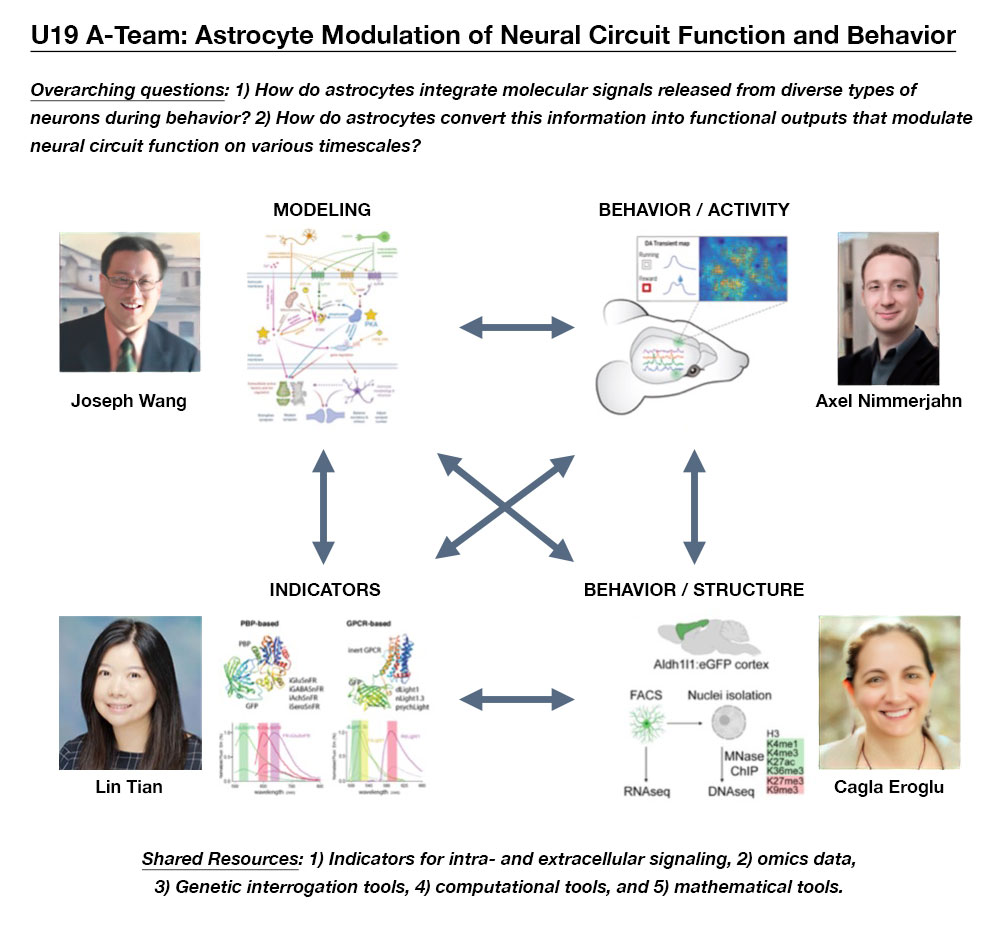Overview
The NIH BRAIN Initiative
The Brain Research through Advancing Innovative Neurotechnologies (BRAIN) Initiative aims to accelerate our understanding of the human brain by promoting the development and application of innovative technologies that will reveal how individual cells and complex neural circuits interact at the speed of thought. This is critical to shed light on the complex links between brain function and behavior.
The Astrocyte-Team BRAIN Circuit Program (A-Team) is an integral component of the BRAIN Initiative. Supported by the U19 funding mechanism, the A-Team Program tackles the fundamental question of astrocytes’ roles in neural circuit processes, complex behaviors, and brain computation.
The Astrocyte-Team Program
“What is the function of glial cells in neural centers? The answer is still not known, and … it may remain unsolved for many years to come until physiologists find direct methods to attack it.” (Ramon y Cajal, 1911)
The problem
Astrocytes, one of the most abundant cell types in the brain, have long been thought of as primarily passive support cells. Over the past two decades, studies have indicated that astrocytes play crucial roles in nervous system development, function, and diseases.
However, a still unresolved issue in neuroscience is how astrocytes integrate diverse neuronal signals under healthy conditions, modulate neural circuit structure and function at multiple temporal and spatial scales, and how aberrant excitation and molecular output influence sensorimotor behavior and contribute to disease.
In response to this challenge, we have formed the U19 A-Team Program. The overall goal of the program is to address this fundamental issue by developing a deeper mechanistic understanding of astrocytes’ roles in neural circuit operation, complex behaviors, and brain computation. The A-Team will tackle this goal by addressing two overarching questions:
1) How do astrocytes temporally and spatially integrate molecular signals from the diverse types of local and projection neurons activated during sensorimotor behaviors?
2) How do astrocytes convert this information into functional outputs that modulate neural circuit structure and function at different spatial and temporal scales?
The approach
The A-Team central hypothesis is that astrocytes operate on diverse spatial and temporal scales as integral, modulatory components of neural circuits. To test this hypothesis, the A-Team has devised an innovative multi-scale approach integrating functional, anatomical, and genetic analyses with theoretical modeling.
Our approach involves quantitative behavioral assays, large-scale imaging of cellular and molecular dynamics, targeted cell-type-specific manipulations, high-throughput omic techniques, genetic profiling, protein engineering, machine learning, and computational modeling. By integrating experimental and theoretical approaches, the A-Team aims to determine the molecular, cellular, and circuit mechanisms by which astrocytes influence neural circuits and contribute to complex behaviors and brain computation.
The experimental data, genetic tools, and computational methods and models developed as part of this Program will be made available to the broader neuroscientific community through web-based tools and atlases.
For more information, please visit https://reporter.nih.gov/project-details/10294800

The Data Science Resource Core
The Data Science Resource Core (DSR Core) provides the infrastructure necessary to collect, manage, visualize, integrate, and distribute the experimental data generated by the A-Team Program. Additionally, the DSR Core develops and implements web-based interfaces for data analysis and visualization, facilitating the use of newly developed tools by the broader scientific community. For more information about the recently released tools, please visit the Computational tools page.
The Administrative Core
The Administrative Core (Admin Core) provides organizational oversight for the four Research Projects and the RDS Core, as well as the administrative infrastructure necessary to coordinate all the scientific, regulatory, and external reporting activities of the U19 A-Team Program. Furthermore, the Admin Core promotes the distribution of the scientific resources generated by this U19 program to the broader research community.
This Program is supported by the National Institute Of Neurological Disorders And Stroke of the National Institutes of Health under Award Number U19NS123719.